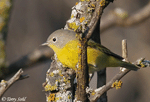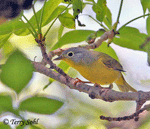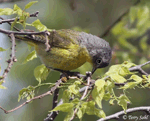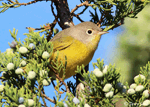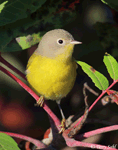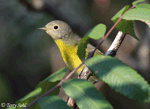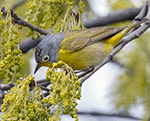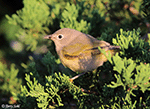| Length: 4.75 inches | Wingspan: 7.5 inches | Seasonality: Migrant |
| ID Keys: Light eye-ring, yellow throat, yellow belly and undertail coverts, no wing-bars. | ||
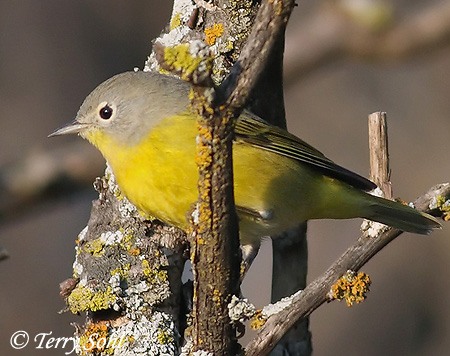 Nashville
Warblers are named for the location at
which the species was first documented, even though it is just a migrant through
the Nashville area. They are more visible than many
migrating warblers, as they generally forage rather low in brush or small
trees. Two distinct breeding populations exist, one in the Pacific
Northwest, and one in the upper Midwest, the Northeast, and southeastern Canada.
Western populations used to be called another species, the "Calaveras Warbler".
Nashville
Warblers are named for the location at
which the species was first documented, even though it is just a migrant through
the Nashville area. They are more visible than many
migrating warblers, as they generally forage rather low in brush or small
trees. Two distinct breeding populations exist, one in the Pacific
Northwest, and one in the upper Midwest, the Northeast, and southeastern Canada.
Western populations used to be called another species, the "Calaveras Warbler".
Habitat:
Breeds in a wide variety of habitats, including deciduous, coniferous or mixed forest, as well as thickets and brushy fields.
Diet:
Almost exclusively insects.
Behavior:
Primarily moves about low in the vegetation, gleaning insects from flowers and leaves. Nesting occurs on the ground.
Nesting:
Non-breeder in South Dakota. On their breeding grounds, Nashville Warbler females build a small cup nest on the ground, typically next to the base of a shrub or thick clump of herbaceous vegetation. The nest is constructed of twigs, moss, roots, and strips of bark, lined with finer grasses and animal hair. The female lays four or five eggs, with both parents helping to incubate them. The young hatch after about 12 days, and fledge from the nest about 10 days after hatching.
Song:
The song of a Nashville Warbler begins with a series of sweet, two-note phrases, followed by a rapid trilling at a lower pitch. They have multiple short call notes.
- Click here to hear the song of a male Nashville Warbler1
- Click here to hear the short chip call of a Nashville Warbler2
Migration:
Summers throughout the Great Lakes region, the northeastern U.S., parts of the northwestern U.S., and south-central and southeast Canada. Winters in Mexico and Central America.
Interactive eBird map:
Click here to access interactive eBird map of Nashville Warbler sightings
Similar Species:
Nashville Warblers have a somewhat similar appearance to a few other warbler species (all migrants in South Dakota)
- Connecticut Warbler - Both Connecticut and Nashville Warblers have yellow underparts, gray on the head, a white eye-ring, and darker grayish or greenish upperparts. However, on a Connecticut Warbler, the gray is found on the forehead, face, and throat, while on a Nashville Warbler, the gray is found on the face, head, and back of the neck. Connecticut Warblers are a much less common migrant in South Dakota than Nashville Warblers.
- Virginia's Warbler - Virginia's Warblers are found in South Dakota, but in the far southwestern part of the state where they breed in a few select spots. Nashville Warblers are primarily found in the eastern part of South Dakota, and only as migrants. In terms of appearance, they share the same bold white eyering, and a gray head with a chestnut crown. However, Virginia's Warblers have are primarily gray on their underparts (with a yellow chin), while Nashville Warblers are mostly yellow underneath.
- Mourning Warbler - Another migrant in South Dakota, Mourning Warblers share some of the same plumage features as a Nashville Warbler, with yellow underparts, greenish upperparts, and gray on the head. However, male Mourning Warblers have darker gray on the head, with the dark gray stretching down across the throat as well. Male Nashville Warblers have a yellow throat. Female Mourning Warblers have a paler gray on the head that makes them more confusing compared to Nashville Warblers. However, the gray on the head extends across the throat (unlike the yellow throat on a Nashville Warbler).
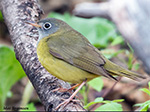 |
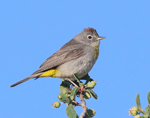 |
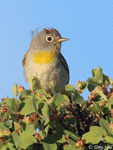 |
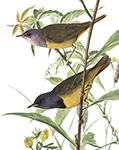 |
| Connecticut Warbler | Virginia's Warbler | Virginia's Warbler | Mourning Warbler |
Conservation Status:
Nashville Warblers are found across a broad geographic area, and are common in parts of their range. Surveys over the last few decades show increases in overall populations. The IUCN considers the Nashville Warbler to be a species of "Least Concern".
Further Information:
Photo Information:
September 2008 - Minnehaha County, South Dakota - Terry Sohl
Additional Photos:
Click on the image chips or text links below for additional, higher-resolution Nashville Warbler photos.
Audio File Credits:
- 1Ken Hall and Peter Ward. Recorded near Leavenworth, Washington on May 2nd, 1983. Original recording and information from xeno-canto.
- 2Frank Lambert. Recorded in Nayarit, Mexico on April 10th, 2015. Original recording and information from xeno-canto.
Click on the map below for a higher resolution view |
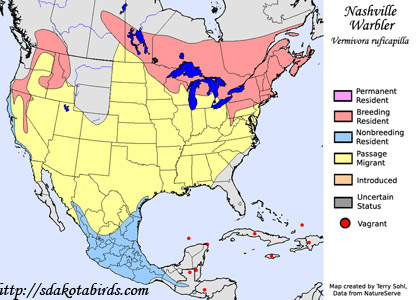 |
| South Dakota Status: Uncommon spring migrant and common fall migrant in the eastern part of the state. Accidental in the west. |
Additional Nashville Warbler Photos
Click for a higher-resolution version of these photos
